Day Trading Monster Stocks
After the 1987 stock market crash, I developed a healthy fear for holding stocks too long, unless you have very deep pockets and can ride out the storms. So I went on a quest to learn how to day trade, remember this was 1988 and there were no fancy charting packages and software back then, only my 12″ Compac with green monochrome bar charts and a $300 per month data feed.
As a day trader, I knew that I needed to find stocks that were poised to move fast. I also knew that I had to buy them at the right moment in time and try and suck as much meat from them as I possibly could, with as small a risk as possible. Anytime I can risk $0.10 to make $0.50 or $1, and I knew whether I am right or wrong quickly, I will take that deal.
I studied price action, volume, supply and demand as well as support and resistance and developed a fairly simple approach to buying breakouts and pullbacks and came up with my most important rule, only buy strong stocks and only short weak stocks.
It really wasn’t rocket science and it worked ok about 65% of the time, but I knew I had to refine the method to increase that percentage if I was really going to make some big money, the missing ingredients were two-fold.
- I needed the best stocks I could find, the real movers and shakers both long and short.
- I needed to find a way to time them, intraday perfectly, so they were ripe to move fast or what I like to now call Beach balls underwater.
It took me many years to achieve these 2 simple goals and I still work on this each and every day but here is the basic process.
In order to find the best stocks, I use a combination of fundamental and technical analysis.
In the early days, fundamental information was not easy to come by. I was looking for stocks that were heavily traded, were in the leading industries, had explosive earnings and revenue growth, were leaders in their space and were what I like to term “in play” and were getting much higher then average volume flows. These stocks can be easily viewed in obvious uptrends or downtrends (if I can’t obviously see a trend, I pass). Also these stocks were usually in the news and making headlines but not always, so back then I really had to dig deep for them. That being said, once you find these stocks they can pay you over and over again for months and months and sometimes years.
These days things are much easier and I use a lot of William Oniel’s work and subscribed to his web site and paper for my fundamental information.
Next, I had to tackle the timing problem, finding price levels on these stocks at the perfect point during the day, where they are stretched too far in the wrong direction from their primary trend for pullbacks or at an area, where I could increase the success of a price breakout being real and rocketing fast.
The market is a “three horse” race. A stock is either going Up, Down or Sideways, right? So why is trading so hard? The answer is timing and I eventually discovered the best tool to do this with — Volatility. Buy a stock right and you’ve got no worries. Combine all of the above filters with volatility and you have an incredibly powerful method that will let you do, what few traders can do.
Tame, the beasts!
Most traders fear monster stocks because of their volatility, but for me, they are just kittens because I understand their power and their limitations and I have a method of measuring their moods and temperament at every moment. A very good trader I know has a saying that I will borrow. because I love it so much: “The market is like a charging pregnant Elephant,” very dangerous but also very predictable if you know how to respect and handle her at the right times. When she charges, you want to be on her back and when she tires, you can safely feed her from your hand.
Below is a very simplified explanation of what I do each day and I use about 3 technical tools in total, as I like to keep things as simple as possible.
To recap: Only buy strong stocks and only short weak stocks!!!
- Find the strongest industries for longs and the weakest industries (for shorts).
- Find the stocks inside these industries that have lots of liquidity and intra day activity, which are in clear and obvious trends and have the best (or worst) fundamentals.
- Do your homework the night before and be prepared the next day, by locating potential trade area’s around various support or resistance zones, then plan your entry and exit strategies.
- Wait for these areas to be reached intraday and if volatility is ripe and price action confirms that the beach ball has been pushed too far underwater, there is only one step left to do.
- Make sure you have the proper risk to reward ratio’s (minimum of 2:1) and IF the trade is there, pull the trigger and place your stop, then sit tight and wait for the result.
At the time of writing this in 2008, I am regularly trading:
Longs
5 Fertilizer stocks: Potash Cp Saskatchewan
(
POT |
Quote |
Chart |
News |
PowerRating), Agrium
(
AGU |
Quote |
Chart |
News |
PowerRating), CF Industries Holdings
(
CF |
Quote |
Chart |
News |
PowerRating), Monsanto
(
MON |
Quote |
Chart |
News |
PowerRating), Mosaic
(
MOS |
Quote |
Chart |
News |
PowerRating)
4 Oil and Gas stocks: Transocean
(
RIG |
Quote |
Chart |
News |
PowerRating), HOLDRS Oil Service
(
OIH |
Quote |
Chart |
News |
PowerRating), Petroleo Brasileiro
(
PBR |
Quote |
Chart |
News |
PowerRating), Eog Resources
(
EOG |
Quote |
Chart |
News |
PowerRating)
Shorts
5 Brokers / Banks : Bank Of America
(
BAC |
Quote |
Chart |
News |
PowerRating), Goldman Sachs
(
GS |
Quote |
Chart |
News |
PowerRating), Lehman Brothers
(
LEH |
Quote |
Chart |
News |
PowerRating), Merrill Lynch
(
MER |
Quote |
Chart |
News |
PowerRating), Citigroup
(
C |
Quote |
Chart |
News |
PowerRating)
I find that no more than 10 longs and 10 shorts are necessary to find 3-4 very high probability trades per day.
Here is an example of a strong stock Potash Cp Saskatchewan
(
POT |
Quote |
Chart |
News |
PowerRating) – notice the high volatility level which equals high probability of price reacting very quickly here.
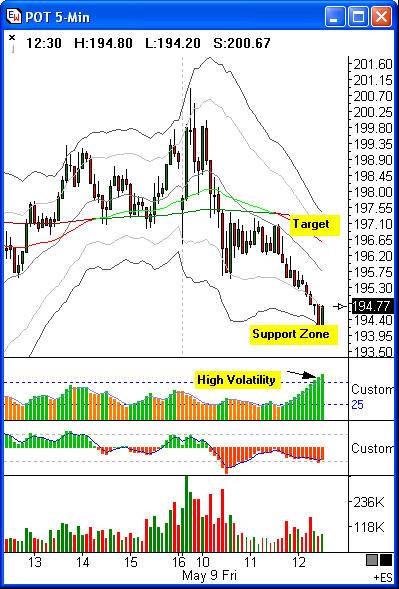
Here are the results:
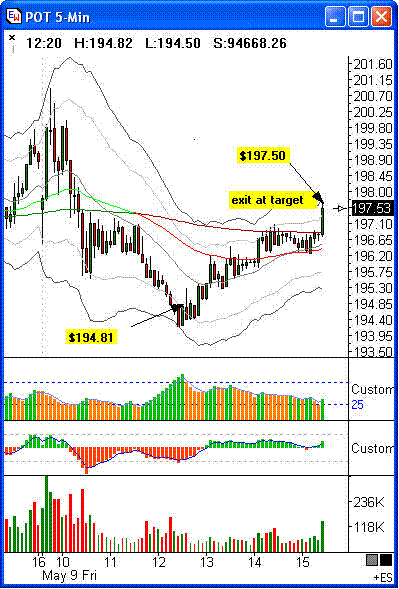
Here is an example of a weak stock Lehman Brothers
(
LEH |
Quote |
Chart |
News |
PowerRating) – once again, notice volatility which equals high probability of fast price reaction.
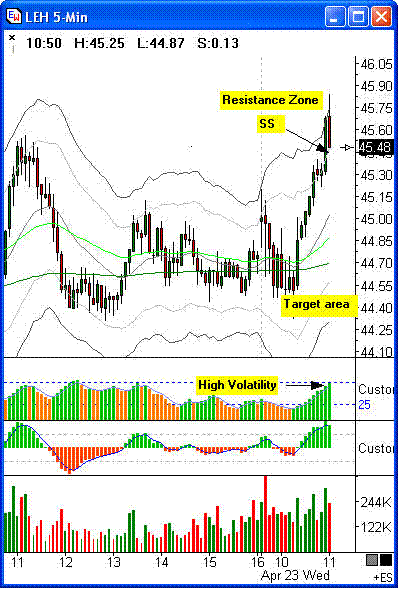
Results:
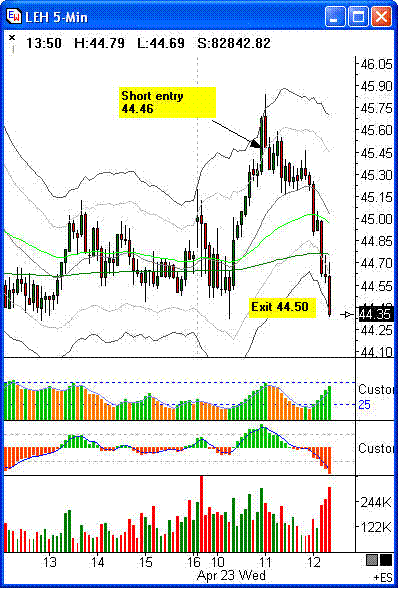
In this final example I will share with you how you can use low volatility periods to give you a higher probability of break out trades working. HOLDRS Oil Service
(
OIH |
Quote |
Chart |
News |
PowerRating) is a leader and I was watching it for a buying opportunity.
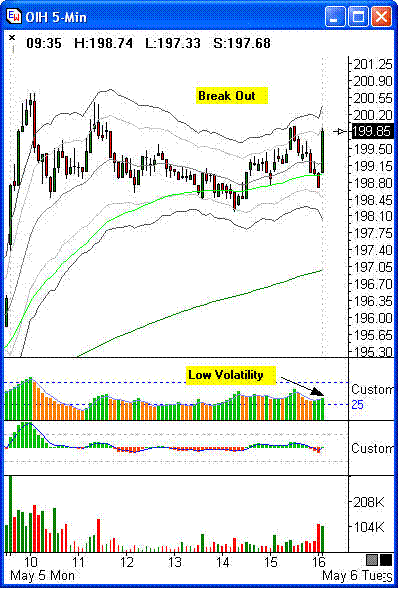
Results:
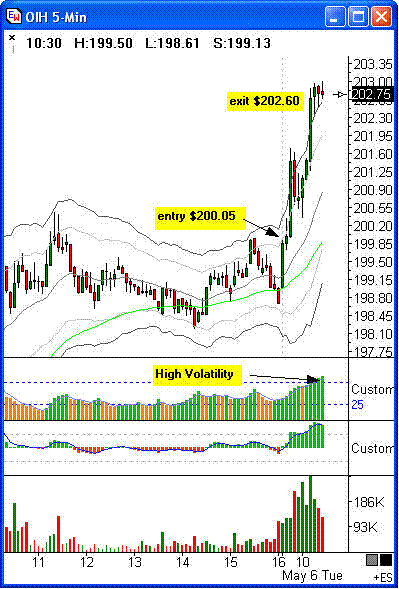
These are just 3 recent examples of how powerful my methods can be !
I shared these trades to help give you a sense of my methods in action and if you are interested in learning how I do trade these monsters each and every day, I have decided to “selectively” open myself up to some mentoring clients. Let me qualify this though! I became a trader because I love the freedom the life brings and as long as I can keep that freedom and mentor, with out impeding on it too much, then I will continue it for awhile. I am 44-years-old now and trading is still great, but I am also getting tired of the daily stresses it brings, so this may work for me should I find it favorable.
I ask that before you contact me, you please consider the following:
I will make no promises or guarantees because I have learned that even when you have great tools and methods that trading really is a mental business. BUT that being said, it sure is a lot easier when your methods are robust and lucrative. Still I make no promises.
Secondly, I do not want people who are on their last leg financially and trading with rent money. This business is already hard enough without that pressure and you will really need at least 6 good months of serious screen time before the light bulbs all go off and you really “get it” and that’s being generous. So have at least that much living expense in the bank on top of your trading capital.
Finally, understand that I trade full time and have a happy home life so you will have to be flexible in scheduling time with me. Like I said I have conditions because I’m happy with my life, so this must fit well.
For anyone serious you can email me and we can discuss a financial arrangement. If not, then I suggest you take these simple concepts I have shared and figure this out on your own, because this style of day trading is as close to the Holy Grail, that you will ever get.
Best of trades to you all.
Sam Patterson has over 20 years of experience in day trading and has worked as both a broker and an analyst. As an apprentice stock broker, Patterson experienced first-hand the stock market crash of 1987. Seeing how easy it was for fortunes to get wiped out overnight, he left the brokerage firm and began day trading for himself. Patterson’s extensive experience on the “front-lines”, gives him the rare ability to teach and share his technical analysis with others. Patterson resides in Canada and is currently an individual day trader. If you would like more information, email Patterson at sptrader@rogers.com.
